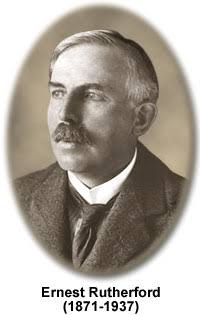Answers of Quiz 1747 (Ernest Rutherford)
1. On 30 August 1871 in New Zealand
2. New Zealand, United Kingdom
3. Physics & Chemistry
4. Rutherford's Atomic Model was an experiment called Gold Metal Foil Experiment.
5. i According to the classical physics, since electron is revolving around the nucleus constantly it should lose energy & it ultimately falls into the nucleus.
ii If the revolving electron emits energy continuously, then there would be a continuous spectrum, but in contrast to it, we get line spectrum from the atoms of element.
6. He passed a beam of alpha particles through a very thin gold metal foil. He found that most of the alpha particles passed through it without any deflection. However some of them deflected at large angles & very few of them bounced back. From this experiment, he proposed that the atom consists of very small, positively charged nucleus in which the most of the mass of the atom is concentrated. The rest of the volume is empty space. However this space is not completely empty & that in it electrons revolve around the nucleus. The proton & neutron reside in the nucleus. Since the protons are positive charged particles, therefore, the nucleus has positive charge. Further since the weight of the atom due to presence of protons & neutrons, as these particles are residing in the nucleus, the weight of the atom is concentrated in the nucleus. The electrons are revolving around the nucleus in the extra nuclear part in various orbits, which are also called as shells, or energy levels.
7. He discovered proton by gold metal foil experiment in 1909.
8. Radioactive decay
9. For his investigations into the disintegration of the elements, & the chemistry of radioactive substances
10. Nuclear Physics is concerned with the structure, properties & reactions of the nuclei of atoms.
11. Ernest Rutherford
12. He discovered alpha & beta rays by radioactivity.
13. He discovered the nucleus of atom by gold metal foil experiment in 1911.
14. (b) Protons & Neutrons
15. Radioactivity is the energy & mass released by spontaneous changes in the nucleus of an atom.
16. The alpha, beta & gamma rays are called Radioactive rays.
17. The radioactive elements continuously emit radiations, as a result they get transformed into new elements. The element emitting radiations is known as parent element & the element formed as a result of the emission of radiation is called daughter element. The emission of radiations from a radio-active substance is a spontanous process. The time interval in which half of the atoms in any given sample decay into daughter elements is known as the half-life of the parent element.
18. On 19 October 1937
19. 66 years




Comments
Post a Comment